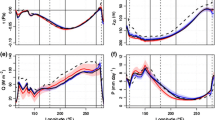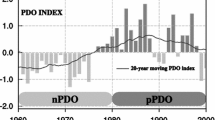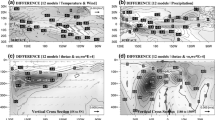Abstract
The El Niño-Southern Oscillation (ENSO) is a naturally occurring coupled phenomenon originating in the tropical Pacific Ocean that relies on ocean–atmosphere feedbacks. The Bjerknes stability index (BJ index), derived from the mixed-layer heat budget, aims to quantify the ENSO feedback process in order to explore the linear stability properties of ENSO. More recently, the BJ index has been used for model intercomparisons, particularly for the CMIP3 and CMIP5 models. This study investigates the effectiveness of the BJ index in representing the key ENSO ocean feedbacks—namely the thermocline, zonal advective, and Ekman feedbacks—by evaluating the amplitudes and phases of the BJ index terms against the corresponding heat budget terms from which they were derived. The output from Australian Community Climate and Earth System Simulator Ocean Model (a global ocean/sea ice flux-forced model) is used to calculate the heat budget in the equatorial Pacific. Through the model evaluation process, the robustness of the BJ index terms are tested. We find that the BJ index overestimates the relative importance of the thermocline feedback to the zonal advective feedback when compared with the corresponding terms from the heat budget equation. The assumption of linearity between variables in the BJ index formulation is the primary reason for these differences. Our results imply that a model intercomparison relying on the BJ index to explain ENSO behavior is not necessarily an accurate quantification of dynamical differences between models that are inherently nonlinear. For these reasons, the BJ index may not fully explain underpinning changes in ENSO under global warming scenarios.







Similar content being viewed by others
References
Adcroft A, Campin JM (2004) Rescaled height coordinates for accurate representation of free-surface flows in Ocean circulation models. Ocean Model 7:269–284
An SI, Jin FF (2001) Collective role of thermocline and zonal advective feedbacks in the ENSO mode. J Clim 14:3421–3432
An SI, Jin FF (2004) Nonlinearity and asymmetry of ENSO. J Clim 17:2399–2412
Ashok K, Behera SK, Rao SA, Weng H, Yamagata T (2007) El Niño Modoki and its possible teleconnection. J Geophys Res 112(C11):1–27. doi:10.1029/2006JC003798
Battisti DS (1988) The dynamics and thermodynamics of a warming event in a coupled tropical atmosphere/Ocean model. J Atmos Sci 45:2889–2919
Battisti DS, Hirst AC (1989) Interannual variability in a tropical atmosphere-Ocean model: influence of the basic State, Ocean geometry and nonlinearity. J Atmos Sci 46(12):1687–1712
Bellenger H, Guilyardi E, Leloup J, Lengaigne M, Vialard J (2013) ENSO representation in climate models: from CMIP3 to CMIP5. Clim Dyn. doi:10.1007/s00382-013-1783-z
Bi D, Marsland SJ, Uotila P, O’Farrell S, Fiedler R, Sullivan A, Griffies SM, Zhou X, Hirst AC (2013) ACCESS-OM: the Ocean and Sea Ice core of the ACCESS coupled model. Aust Meteorol Oceanogr J 63(1):213–232
Bjerknes J (1969) Atmospheric teleconnections from the equatorial Pacific. Mon Weather Rev 97(3):163–172
Brown JN, Godfrey JS, Wijffels SE (2010) Nonlinear effects of tropical instability waves on the equatorial Pacific circulation. J Phys Oceanogr 40(2):381–393. doi:10.1175/2009JPO3963.1
Cane MA, Zebiak SE (1985) A theory for El Nino and the Southern qscillation. Science (New York, NY) 228(4703):1085–7. doi:10.1126/science.228.4703.1085
Choi KY, Vecchi GA, Wittenberg AT (2013) ENSO Transition, duration and amplitude asymmetries: role of the nonlinear wind stress coupling in a conceptual model. J Clim pp 1–36
Collins M, An SI, Cai W, Ganachaud A, Guilyardi E, Jin FF, Jochum M, Lengaigne M, Power S, Timmermann A, Vecchi GA, Wittenberg AT (2010) The impact of global warming on the Tropical Pacific Ocean and El Niño. Nat Geosci 3:391–397
Danabasoglu G, Yeager S, Bailey D, Behrens E, Bentsen M, Bi D, Biastoch A, Boening C, Bozec A, Canuto V, Cassou C, Chassignet E, Coward A, Danilov S, Diansky N, Drange H, Farneti R, Fernandez E, Fogli PG, Forget G, Fujii Y, Griffies S, Gusev A, Heimbach P, Howard A, Jung T, Kelley M, Large W, Leboissetier A, Lu J, Madec G, Marsland S, Masina S, Navarra A, Nurser AG, Pirani A, Salas y Melia D, Samuels B, Scheinert M, Sidorenko D, Treguier AM, Tsujino H, Uotila P, Valcke S, Voldoire A, Wang Q (2014) North Atlantic simulations in coordinated ocean-ice reference experiments phase ii (CORE-II). Part I: Mean states.. Ocean Model 73:76–107. doi:10.1016/j.ocemod.2013.10.005
Dewitte B, Yeh SW, Thual S (2013) Reinterpreting the thermocline feedback in the western-central equatorial Pacific and its relationship with the ENSO modulation. Clim Dyn 41:819–830. doi:10.1007/s00382-012-1504-z
DiNezio PN, Kirtman BP, Clement AC, Lee SK, Vecchi GA, Wittenberg A (2012) Mean climate controls on the simulated response of ENSO to increasing greenhouse gases. J Clim 25(21):7399–7420. doi:10.1175/JCLI-D-11-00494.1
Fedorov AV, Philander SG (2001) A stability analysis of Tropical ocean–atmosphere interactions: bridging measurements and theory for El Nino. J Clim 14(1998):3086–3101
Frauen C, Dommenget D (2010) El Niño and La Niña amplitude asymmetry caused by atmospheric feedbacks. Geophys Res Lett 37(18):L18,801. doi:10.1029/2010GL044444
Gebbie G, Eisenman I, Wittenberg AT, Tziperman E (2007) Modulation of westerly wind bursts by sea surface temperature: a semistochastic feedback for ENSO. J Atmos Sci 64:3281–3295
Griffies SM (2009) Elements of MOM4p1: GFDL Ocean Group Tech. Rep. 6. NOAA/Geophysical Fluid Dynamics Laboratory
Griffies SM, Winton M, Samuels B, Danabasoglu G, Yeager S, Marsland S, Drange H, Bentsen M (2012) Datasets and protocol for the CLIVAR WGOMD coordinated ocean-sea ice reference experiments (COREs). WCRP Report No. 21/2012, pp. 21
Guilyardi E, Wittenberg AT, Fedorov AV, Collins M, Wang C, Capotondi A, van Oldenborgh GJ, Stockdale T (2009) Understanding El Niño in ocean–atmosphere general circulation models: progress and understanding. Bull Am Meteorol Soc March 90:325–340. doi:10.1175/2010JCLI3373.1
Huang B, Xue Y, Zhang D, Kumar A, McPhaden MJ (2010) The NCEP GODAS Ocean analysis of the Tropical Pacific mixed layer heat budget on seasonal to interannual time scales. J Clim 23(18):4901–4925. doi:10.1175/2010JCLI3373.1
Huang B, Xue Y, Wang H, Wang W, Kumar A (2011) Mixed layer heat budget of the El Niño in NCEP climate forecast system. Clim Dyn 39(1-2):365–381. doi:10.1007/s00382-011-1111-4
Hunke E, Lipscomb W (2010) CICE: the Los Alamos Sea Ice Model Documentation and Software User’s Manual. Los Alamos, LA-CC-06-012 Tech. Rep. edn
Jin FF (1997) An equatorial ocean recharge paradigm for ENSO. Part I: conceptual model. J Atmos Sci 54:811–829
Jin FF (1997) An equatorial ocean recharge paradigm for ENSO. Part II: A stripped-down coupled model. J Atmos Sci 54:830–847
Jin FF, An SI (1999) Thermocline and zonal advective feedbacks within the equatorial ocean recharge oscillator model for ENSO. Geophys Res Lett 26(19):2989–2992
Jin FF, An SI, Timmermann A, Zhao J (2003) Strong El Niño events and nonlinear dynamical heating. Geophys Res Lett 30(3):1120. doi:10.1029/2002GL016356
Jin FF, Kim ST, Bejarano L (2006) A coupled-stability index for ENSO. Geophys Res Lett 33(23):L23,708. doi:10.1029/2006GL027221
Karnauskas KB (2013) Can we distinguish canonical El Niño from Modoki?. Geophys Res Lett 40:5246–5251. doi:10.1002/grl.51007
Kessler WS, Rothstein LM, Chen D (1998) The annual cycle of SST in the Eastern Tropical Pacific, diagnosed in an ocean GCM. J Clim 11:777–799
Kim ST, Jin FF (2010) An ENSO stability analysis. Part I: results from a hybrid coupled model. Clim Dyn 36(7-8):1593–1607. doi:10.1007/s00382-010-0796-0
Kim ST, Jin FF (2010) An ENSO stability analysis. Part II: results from the twentieth and twenty-first century simulations of the CMIP3 models. Clim Dyn 36(7-8):1609–1627. doi:10.1007/s00382-010-0872-5
Kim ST, Cai W, Jin FF, Yu JY (2013) ENSO Stability in coupled climate models and its association with mean state. Clim Dyn doi:10.1007/s00382-013-1833-6
Kug JS, Choi J, An SI, Jin FF, Wittenberg A (2010) Warm pool and cold tongue El Niño events as simulated by the GFDL 2.1 coupled GCM. J Clim 23:1226–1239
Large W, Yeager S (2009) The global climatology of an interannually varying air–sea flux data set. Clim Dyn 33: 341. doi:10.1007/s00,382-008-0441-3
Large W, McWilliams J, Doney S (1994) Oceanic vertical mixing: a review and a model with a nonlocal boundary layer parameterization. Rev Geophys 32(4):363–403
Lee HC, Rosati A, Spelman M (2006) Barotropic tidal mixing effects in a coupled climate model: oceanic conditions in the Northern Atlantic. Ocean Model 3(4):464–477
Lengaigne M, Hausmann U, Madec G, Menkes CE, Vialard J, Molines JM (2011) Mechanisms controlling warm water volume interannual variations in the equatorial Pacific: diabatic versus adiabatic processes. Clim Dyn 38(5-6):1031–1046. doi:10.1007/s00382-011-1051-z
Lloyd J, Guilyardi E, Weller H (2011) The role of atmosphere feedbacks during ENSO in the CMIP3 models. Part II: using AMIP runs to understand the heat flux feedback mechanisms. Clim Dyn 37(7-8):1271–1292. doi:10.1007/s00382-010-0895-y
Lloyd J, Guilyardi E, Weller H (2012) The role of atmosphere feedbacks during ENSO in the CMIP3 models. Part III: the shortwave flux feedback. J Clim 25(12):4275–4293. doi:10.1175/JCLI-D-11-00178.1
Lübbecke JF, McPhaden MJ (2013) A comparative stability analysis of Atlantic and Pacific Niño modes. J Clim 26:5965–5980. doi:10.1175/JCLI-D-12-00758.1
Murray R (1996) Explicit generation of orthogonal grids for ocean models. J Comput Phys 126(2):251–275. doi:10.1006/jcph.1996.0136
Neelin JD, Jin FF (1993) Modes of interannual tropical ocean–atmosphere interactions - a unified view. Part II: analytical results in the weak-coupling limit. J Atmos Sci 50(21):3504–3522
Ogata T, Xie SP, Wittenberg AT, Sun DZ (2013) Interdecadal amplitude modulation of El Niño/Southern oscillation and its impacts on Tropical Pacific decadal variability. J Clim. doi:10.1175/JCLI-D-12-00415.1
Oke PR, Sakov P, Cahill ML, Dunn JR, Fiedler R, Griffin DA, Mansbridge JV, Ridgway KR, Schiller A (2013) Towards a dynamically balanced eddy-resolving ocean reanalysis: BRAN3. Ocean Model 67:52–70. doi:10.1016/j.ocemod.2013.03.008
Philander SGH (1990) El Niño, La Niña and the Southern oscillation. Academic Press, Waltham, p 289
Philander SGH, Yamagata T, Pacanowski RC (1984) Unstable air-sea interactions in the tropics. J Atmos Sci 41(4):604–613
Picaut J, Ioualalen M, Menkes C, Delcroix T, McPhaden M (1996) Mechanism of the zonal displacements of the Pacific warm pool: implications for ENSO. Science (New York, NY) 274(5292):1486–9
Qu T (2003) Mixed layer heat balance in the Western North Pacific. J Geophys Res 108(C7):3242. doi:10.1029/2002JC001536
Rebert J, Donguy J, Eldin G (1985) Relations between sea level, thermocline depth, heat content, and dynamic height in the Tropical Pacific Ocean. J Geophys Res 90(C6):11719–11725
Ren H, Jin FF (2013) Recharge oscillator mechanisms in two types of ENSO. J Clim. doi:10.1175/JCLI-D-12-00601.1
Ridgway KR, Dunn JR, Wilkin J (2002) Ocean interpolation by four-dimensional least squares - application to the waters around Australia. J Atmos Ocean Technol 19(9):1357–1375
Santoso A, Sen Gupta A, England MH (2010) Genesis of Indian Ocean mixed layer temperature anomalies: a heat budget analysis. J Clim 23(20):5375–5403. doi:10.1175/2010JCLI3072.1
Schiller A, Ridgway KR (2013) Seasonal mixed layer dynamics in an eddy-resolving Ocean circulation model. J Geophys Res 118:1–19. doi:10.1002/jgrc.20250
Schopf PS, Suarez MJ (1988) Vacillations in a coupled ocean–atmosphere model. J Atmos Sci 45(3):549–566
Sen Gupta A, Brown JR, Muir LC, Risbey JS, Whetton P, Zhang X, Ganachaud A, Murphy B, Wijffels SE (2012) Implications of CMIP3 model biases and uncertainties for climate projections in the western tropical Pacific. Climatic Change. doi:10.1007/s10584-012-0603-5
Simmons H, Jayne S, Laurent L, Weaver A (2004) Tidally driven mixing in a numerical model of the ocean general circulation. Ocean Model 6:245–263
Singh A, Delcroix T, Cravatte S (2011) Contrasting the Flavors of El Niño-Southern Oscillation using Sea Surface Salinity Observations. Journal of Geophysical Research 116(C06016). doi:10.1029/2010JC006862
Smith NR (1995) The BMRC ocean thermal analysis system. Aust Meteorol Mag 44:93–110
Timmermann A, Jin FF, Abshagen J (2003) A nonlinear theory for El Nino bursting. J Atmos Sci 60:152–165
Vecchi GA, Wittenberg AT (2010) El Niño and Our Future Climate: Where do We Stand? Wiley Interdisciplinary Reviews: Climate Change 1(April), doi:10.1002/wcc.33
Vecchi GA, Wittenberg AT, Rosati A (2006) Reassessing the Role of Stochastic Forcing in the 1997-8 El Niño. Geophysical Research Letters L01706. doi:10.1029/2005GL024,738
Wang W, McPhaden MJ (2000) The surface-layer heat balance in the Equatorial Pacific Ocean. Part II: interannual variability. J Phys Oceanogr 30:2989–3008
Watanabe M, Kug JS, Jin FF, Collins M, Ohba M, Wittenberg AT (2012) Uncertainty in the ENSO amplitude change from the past to the future. Geophys Res Lett 39(20):1–6. doi:10.1029/2012GL053305
Wittenberg AT (2009) Are historical records sufficient to constrain ENSO simulations? Geophys Res Lett 36(12):L12,702 doi:10.1029/2009GL038710
Wyrtki K (1975) El Nino - the dynamic response of the Equatorial Pacific Ocean to atmospheric forcing. J Phys Oceanogr 5:572–584
Yeh SW, Dewitte B, Yim BY, Noh Y (2010) Role of the upper ocean structure in the response of ENSO-like SST variability to global warming. Clim Dyn 35:355–369. doi:10.1007/s00382-010-0849-4
Zebiak SE, Cane MA (1987) A model El Nino-Southern oscillation. Mon Weather Rev 115:2262–2278
Zhang X, McPhaden MJ (2010) Surface layer heat balance in the Eastern Equatorial Pacific Ocean on interannual time scales: influence of local versus remote wind forcing. J Clim 23(16):4375–4394. doi:10.1175/2010JCLI3469.1
Acknowledgments
We would like to thank Dietmar Dommenget and Simon Wotherspoon for helpful discussions on this work, and SeonTae Kim, Agus Santoso and two anonymous reviewers for providing useful feedback to improve the manuscript. The ACCESS-OM model is supported by the Australian Government Department of the Environment, the Bureau of Meteorology and CSIRO through the Australian Climate Change Science Program, and the NCI National Facility at the ANU. The CARS MLD product was derived from the CSIRO Atlas of Regional Seas from CSIRO Marine and Atmospheric Research. This research is supported by an Australian Postgraduate Award and a CSIRO Wealth from Oceans scholarship and makes a contribution to the ARC Centre of Excellence for Climate System Science.
Author information
Authors and Affiliations
Corresponding author
Electronic supplementary material
Below is the link to the electronic supplementary material.
382_2014_2062_MOESM1_ESM.eps
Online Resource 1 Comparison between mean surface (upper plots) and mean equatorial subsurface (lower plots) potential temperature data derived from ACCESS-OM (far left panels) and the Bureau of Meteorology Research Centre (BMRC) ocean thermal reanalysis system (middle panels; Smith, 1995). The far right panels show the difference between the ACCESS-OM and the BMRC data, where stippling indicates differences significant at the 95% confidece interval. Data are in units of \(^{\circ}\hbox{C}\). The ACCESS-OM data are averaged over the period 1980-2007 and the BMRC data are averaged over the period 1980-2004. Below is the link to the electronic supplementary material. EPS (11,094 KB)
382_2014_2062_MOESM2_ESM.eps
Online Resource 2 Comparison between mean surface zonal current data (m s−1) derived from ACCESS-OM (far left panel) and OSCAR (middle panel; available at http://www.oscar.noaa.gov/). The far right panel shows the difference between the ACCESS-OM and OSCAR data, where stippling indicates differences significant at the 95% confidence interval. The ACCESS-OM data are averaged over the period 1980-2007 and the OSCAR data are averaged over the period 1993-2012. Below is the link to the electronic supplementary material. EPS (10,311 KB)
382_2014_2062_MOESM3_ESM.eps
Online Resource 3 Difference between seasonal sea surface temperature (\(^{\circ}\hbox{C}\)) derived from the ACCESS-OM simulation and the BMRC data. Stippling indicates differences significant at the 95% confidence interval. Below is the link to the electronic supplementary material. EPS (5,109 KB)
Appendix
Appendix
1.1 Derivation of the BJ index
The BJ index is derived from the linearized anomalous temperature tendency equation, namely
where the overline notation denotes climatological fields (i.e. averaged over the full time period) and the prime denotes anomalous fields that have the seasonal cycle removed. In what follows we drop the prime notation. The terms in Eq. (19) are averaged vertically, from the ocean surface to the MLD, and horizontally in the central-eastern equatorial Pacific 5°S–5°N, 175°E–80°W), in which the majority of ENSO variability occurs, yielding
where L x and L y are the longitudinal and latitudinal extents of the central-eastern box, respectively, and the factor −2y/L y assumes that the tropical SST anomalies are Gaussian with an e-folding decay scale of L y . The term H BJ is the MLD, T H is the temperature at the grid point just below the mixed layer, and \(H(\overline{w})\) ensures that only the vertical motion into the mixed layer affects the mixed layer heat budget. Note that in deriving Eq. (20), the small term \(-v^{\prime} \partial T/\partial y\) has been omitted, consistent with Jin et al. (2006). A series of balance equations from section 3 [Eqs. (9–11), (13), (15), and (17)] are applied to approximate the terms in Eq. (20). These balance equations yield coefficients that estimate the strength of the air–sea coupling μ, the sensitivity of oceanic responses to surface winds β h , β u , β w , and the magnitude of advection by mean currents and thermodynamic damping. Collectively, they enable the temperature tendency in Eq. (20) to be separated into growth and frequency components, expressed in the form of the recharge oscillator model (Jin 1997a), namely,
Here the coefficients R and F are explicit functions of the basic state, rather than simply coefficients estimated via regression to observations or model data. R is the growth term that underpins the BJ index, and is given by
and the frequency term F is given by
Rights and permissions
About this article
Cite this article
Graham, F.S., Brown, J.N., Langlais, C. et al. Effectiveness of the Bjerknes stability index in representing ocean dynamics. Clim Dyn 43, 2399–2414 (2014). https://doi.org/10.1007/s00382-014-2062-3
Received:
Accepted:
Published:
Issue Date:
DOI: https://doi.org/10.1007/s00382-014-2062-3




